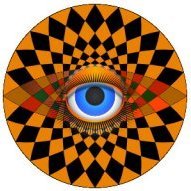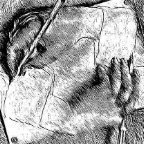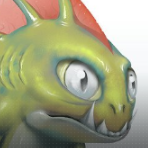-
Posts
1,151 -
Joined
-
Last visited
Reputation Activity
-
 smadell reacted to DM1 in Graphic Novel Effect
smadell reacted to DM1 in Graphic Novel Effect
Thanks. Works great on iPad (apart from option to select number of colour levels before converting). It is possible to go into adjustment layer later and set it though.🙂
-

-
 smadell got a reaction from Undix Galore in Affinity Photo from 10,000 Feet - Free PDF
smadell got a reaction from Undix Galore in Affinity Photo from 10,000 Feet - Free PDF
I am attaching a free PDF called “Affinity Photo from Ten Thousand Feet.” This is a 41 page book that explains many of the concepts and questions that forum members ask frequently.
Much of the information is based on presentations given to my local photography club. Some of it is based on a series of articles written for the club’s newsletter. Much of the book is newly written material, based on years of working to understand digital photography, how color works, and how Affinity Photo fits into that picture.
Please enjoy the book. All I ask in return is that you look it over and leave a comment.
Affinity_Photo_from_Ten_Thousand_Feet.pdf
-
 smadell got a reaction from rvst in Inverted Mask?
smadell got a reaction from rvst in Inverted Mask?
This puzzle actually has a really simple solution. There is no need to combine the two vector shapes in any way whatsoever – each of them remains completely editable. I have given an example below.
Put the rectangle (or, really, anything) in a layer over the background. Then, put the second shape (in this case, a star) over the rectangle. Set the Blend Mode of the top layer (the star) to "Erase." This will drill a hole through the entire image, revealing the blank canvas underneath. I know, I know, that's not what you want.
So, put the rectangle and the star into a Group. This will force the Erase blend mode to work ONLY on the rectangle. The star and the rectangle remain 100% editable, as does the background.
-

-
 smadell got a reaction from Larry44 in Panorama Warping Help
smadell got a reaction from Larry44 in Panorama Warping Help
Use the Mesh Warp tool. Set the horizon where you want it to be, switch to "Source" mode (in the Context Toolbar) and drag the mesh line to match where the horizon IS in your photo, then switch back to "Destination" mode to warp the image to where you want it. See below...
Panorama Warp Correction.mp4 -
 smadell got a reaction from jdvoracek in Luminosity Masks
smadell got a reaction from jdvoracek in Luminosity Masks
In response to a post I made last May, MJSfoto1956 suggested the use of Blend Options as an alternative to more traditional luminosity masks. It turns out that the use of the Blend Options panel, combined with a little math, makes luminosity based selections quite effective. The trouble is that the method is cumbersome if you do them from scratch each time.
What I have created is a series of Macros that automates the process. The attached afmacros file contains macros for creating Luminosity Selections in their usual and anticipated forms: Lights 1 through Lights 4, Darks 1 through Darks 4, and Midtones 1 through Midtones 4.
Notes:
1) Each action will select a luminosity-based portion of the selected layer.
2) NO additional channels are created, so files don’t become bloated.
3) Once the selection is made, it can be used for an adjustment layer, a mask, a live filter, etc. It can be deselected (like any selection). It can be replaced by using a different selection (e.g., click on Lights 2 to replace the selection made by Lights 1).
Caveats:
4) You must have a Pixel layer or an Image layer selected for the macros to work properly. If you have any other type of layer selected, or if you have NO layer selected, the results you get will be wrong.
5) The macros will undo any Blend Options you may have set on the selected layer.
6) I am one person with one computer. Obviously, I have not tested these macros in every possible situation. Use them if you like them. No guarantees are made.
7) However, if you like them, they are yours. They are my way of saying “thank you” to the Forum for helping me learn a wonderful piece of software!
Luminosity Selections.afmacros.zip
-
 smadell got a reaction from firstdefence in Panorama Warping Help
smadell got a reaction from firstdefence in Panorama Warping Help
Use the Mesh Warp tool. Set the horizon where you want it to be, switch to "Source" mode (in the Context Toolbar) and drag the mesh line to match where the horizon IS in your photo, then switch back to "Destination" mode to warp the image to where you want it. See below...
Panorama Warp Correction.mp4 -
 smadell got a reaction from Alfred in Panorama Warping Help
smadell got a reaction from Alfred in Panorama Warping Help
Use the Mesh Warp tool. Set the horizon where you want it to be, switch to "Source" mode (in the Context Toolbar) and drag the mesh line to match where the horizon IS in your photo, then switch back to "Destination" mode to warp the image to where you want it. See below...
Panorama Warp Correction.mp4 -
 smadell reacted to dmstraker in Affinity Photo from 10,000 Feet - Free PDF
smadell reacted to dmstraker in Affinity Photo from 10,000 Feet - Free PDF
Nicely done, @smadell, and thanks for the InAffinity reference.
For a future version if you like, I keep a parallel web-based index (and resources) here: http://changingminds.org/disciplines/photography/affinity_photo/affinity_photo.htm
-
 smadell got a reaction from Boldlinedesign in Affinity Photo from 10,000 Feet - Free PDF
smadell got a reaction from Boldlinedesign in Affinity Photo from 10,000 Feet - Free PDF
I am attaching a free PDF called “Affinity Photo from Ten Thousand Feet.” This is a 41 page book that explains many of the concepts and questions that forum members ask frequently.
Much of the information is based on presentations given to my local photography club. Some of it is based on a series of articles written for the club’s newsletter. Much of the book is newly written material, based on years of working to understand digital photography, how color works, and how Affinity Photo fits into that picture.
Please enjoy the book. All I ask in return is that you look it over and leave a comment.
Affinity_Photo_from_Ten_Thousand_Feet.pdf
-
 smadell got a reaction from StudioJason in Affinity Photo from 10,000 Feet - Free PDF
smadell got a reaction from StudioJason in Affinity Photo from 10,000 Feet - Free PDF
Thank you for your comments, @StudioJason. I appreciate it.
I don't think that I'll be creating an "alternate" version for the iPad, though. The idea of the book was to deal primarily with concepts rather than with the specifics of the interface. I know that there was some UI explanation done, and that it assumed the use of the desktop version; other than a few of the images and an explanation of the menu commands (mostly their location) I don't think that anything significant would be different.
Nevertheless, I'm glad you found the book to be worth reading and worth recommending! Thank you again.
-
 smadell got a reaction from Jays in Affinity Photo from 10,000 Feet - Free PDF
smadell got a reaction from Jays in Affinity Photo from 10,000 Feet - Free PDF
I am attaching a free PDF called “Affinity Photo from Ten Thousand Feet.” This is a 41 page book that explains many of the concepts and questions that forum members ask frequently.
Much of the information is based on presentations given to my local photography club. Some of it is based on a series of articles written for the club’s newsletter. Much of the book is newly written material, based on years of working to understand digital photography, how color works, and how Affinity Photo fits into that picture.
Please enjoy the book. All I ask in return is that you look it over and leave a comment.
Affinity_Photo_from_Ten_Thousand_Feet.pdf
-
 smadell got a reaction from Tom Lachecki in Affinity Photo from 10,000 Feet - Free PDF
smadell got a reaction from Tom Lachecki in Affinity Photo from 10,000 Feet - Free PDF
I am attaching a free PDF called “Affinity Photo from Ten Thousand Feet.” This is a 41 page book that explains many of the concepts and questions that forum members ask frequently.
Much of the information is based on presentations given to my local photography club. Some of it is based on a series of articles written for the club’s newsletter. Much of the book is newly written material, based on years of working to understand digital photography, how color works, and how Affinity Photo fits into that picture.
Please enjoy the book. All I ask in return is that you look it over and leave a comment.
Affinity_Photo_from_Ten_Thousand_Feet.pdf
-
 smadell got a reaction from Archangel in Affinity Photo from 10,000 Feet - Free PDF
smadell got a reaction from Archangel in Affinity Photo from 10,000 Feet - Free PDF
I am attaching a free PDF called “Affinity Photo from Ten Thousand Feet.” This is a 41 page book that explains many of the concepts and questions that forum members ask frequently.
Much of the information is based on presentations given to my local photography club. Some of it is based on a series of articles written for the club’s newsletter. Much of the book is newly written material, based on years of working to understand digital photography, how color works, and how Affinity Photo fits into that picture.
Please enjoy the book. All I ask in return is that you look it over and leave a comment.
Affinity_Photo_from_Ten_Thousand_Feet.pdf
-
 smadell got a reaction from Rizalrif007 in Affinity Photo from 10,000 Feet - Free PDF
smadell got a reaction from Rizalrif007 in Affinity Photo from 10,000 Feet - Free PDF
I am attaching a free PDF called “Affinity Photo from Ten Thousand Feet.” This is a 41 page book that explains many of the concepts and questions that forum members ask frequently.
Much of the information is based on presentations given to my local photography club. Some of it is based on a series of articles written for the club’s newsletter. Much of the book is newly written material, based on years of working to understand digital photography, how color works, and how Affinity Photo fits into that picture.
Please enjoy the book. All I ask in return is that you look it over and leave a comment.
Affinity_Photo_from_Ten_Thousand_Feet.pdf
-
 smadell got a reaction from j3rry in 38 Gradient Maps for Color Grading
smadell got a reaction from j3rry in 38 Gradient Maps for Color Grading
Today, let’s have fun with Gradient Maps…
Gradient Maps are a great way to color grade photos, since they map dark, light, and midtone values according to a pre-defined gradient. This can easily define a “look” for photos that might otherwise be hard to accomplish.
Although I am not a user of Photoshop, our “arch rival” has a wonderful group of gradient maps called “Photographic Toning” that are specifically designed to color grade photos. Although you have to drill down through a few panels and dialog boxes to find them (and you sort of have to know they’re there in the first place) they are a truly nice addition. Also, they are easily obtained by anyone.
But, as they say, there’s the rub. Affinity Photo cannot import Photoshop gradient maps. Affinity Photo can store pre-defined gradients in the Swatches studio, but for some unknown reason the stored gradients are not available from the Gradient Map studio panel. Gradient Maps can be stored as presets, and can be chosen from the Adjustments panel, but I don’t believe they can be easily exported from one computer and brought into a different one.
So… after a long couple of days of transcription, I have created a set of Macros that apply each of the 38 Photographic Toning gradient maps. Since macros are easy to store, and to share, I am making them available for anyone who wants them.
There are actually 2 sets of Macros included - each as an easy-to-import Category from the Library panel. The first group of Macros is called “Photographic Toning Gradients” and these are named according to the gradient map they apply. Each macro creates a Gradient Map layer, applies the appropriate color values, and names the layer according to the gradient map it applied. The second set of macros is called “Photographic Toning Gradients - reduced.” This category also applies the gradient maps in a similar fashion, but then reduces the opacity of the layer to 30%. This reduces the effect of the Gradient Map, and produces a much subtler effect.
Here is an image that shows the full-strength versions of all 38 gradient maps.
And here is a photo to which I’ve applied a full-strength gradient map, and also a reduced-strength gradient map.
These macro categories are included in the ZIP file attached to this post, along with a Letter sized JPG that includes samples of the gradient maps. Also included in the ZIP file is another macro category that includes one more macro. It’s called “Obama Hope Poster” and, as you might have guessed, it turns any photo into an Obama Hope-style poster. Just because…
Please enjoy them!
Photographic Toning Gradient Maps.zip
-
 smadell got a reaction from surajrv6 in Feature request: color correction option for masks
smadell got a reaction from surajrv6 in Feature request: color correction option for masks
This same technique will also work with Curves.
Apply Levels to Mask.mp4 -
 smadell got a reaction from Frozen Death Knight in Add Film Grain (free macros)
smadell got a reaction from Frozen Death Knight in Add Film Grain (free macros)
Adding grain to a photo is a nice way to emulate vintage images, especially older black and white photos. It has always bothered me a bit that Affinity Photo does not include a mechanism to introduce grain, other than to use the “Add Noise” filter. While adding noise is nice, it adds such a fine amount of variation that it is often quite literally unnoticeable.
I have admired the Film Grain effect that is available in other software, such as Nik’s Silver Efex. These filters can often vary grain size and intensity; sometimes grain can be added to shadows, midtones, and highlights in differing amounts.
What I’ve attached is an .afmacros file called Film Grain. This is a macros Category and should be imported into the Library panel. It includes two macros. The first is called Add Film Grain - simple. It allows the user to add grain with 2 parameters – intensity and size.
Grain - Intensity
The grain intensity defaults to 100%, but can be set to any value between 0 and 100. At 0% intensity, the grain effectively disappears. To understand intensity, think “contrast.”
Grain - Size
The size slider accepts values between 0 and 1, with the default being 0.2. The appropriate value will differ based on the image being treated, and the same perceived size might need higher values when the overall dimensions of the image are larger. Also note that values above 0.8 are rounded down to 0.8 (and this forms an effective upper limit to the slider). This is done primarily because the math breaks down at higher values.
The second macro is called Add Film Grain - by tonal range. It includes the same intensity and size parameters, but also lets the user set opacity levels for highlights, midtones, and shadows separately.
Grain Opacity - Highlights, Midtones, and Shadows
There are three separate sliders for highlights, midtones, and shadows respectively. Each defaults to 100%, but can be set to values between 0 and 100. While the “simple” macro creates a single Film Grain layer, the “tonal range” version creates a group containing 3 layers, one each for the three tonal ranges. The Grain Opacity sliders simply vary the opacity of the corresponding layers within that group.
Finishing Touches
When each of the macros finishes, the Blend Range for the result (the Film Grain layer in the case of the “simple” macro, and the Group in the case of the “tonal range” macro) is set to diminish the effect of the grain on the highlights slightly. This is an aesthetic choice on my part, and I think you will agree. However, you can set the Blend Range to anything you might like, as desired.
* * * * * * * * * * * * * * * * * * * * * * * *
For most users, the “simple” macro will be enough. It lets the editor vary the Intensity of the grain and also the Size. I have always liked adding grain that was a bit larger, because it becomes more noticeable.
For other users, the “tonal range” macro will allow you to add some additional nuance to the grain, by letting you emphasize grain in the shadows, midtones and highlights. Do this by first setting a global Intensity and Size, and then adjusting the opacity of the 3 tone ranges as desired.
* * * * * * * * * * * * * * * * * * * * * * * *
Here are samples of the two macros, along with the settings as applied. The differences between the two results is quite subtle, but might be worth the effort in some cases.
* * * * * * * * * * * * * * * * * * * * * * * *
As with all the macros I have posted, I have tested these on one computer under a limited number of conditions. I cannot guarantee anything, but I have no reason to think they will not work for you just as they have for me. The macros are free, with the suggestion to “pay it forward.” As you become more proficient, be sure to share your experience and your work with others.
By the way, happy holidays to everyone. Here’s hoping that 2021 is a more positive, uplifting year than 2020. And maybe, just maybe, we’ll be able to ring in 2022 in a crowd without any masks!
Film Grain.afmacros
-
 smadell got a reaction from javierr in Inverted Mask?
smadell got a reaction from javierr in Inverted Mask?
This puzzle actually has a really simple solution. There is no need to combine the two vector shapes in any way whatsoever – each of them remains completely editable. I have given an example below.
Put the rectangle (or, really, anything) in a layer over the background. Then, put the second shape (in this case, a star) over the rectangle. Set the Blend Mode of the top layer (the star) to "Erase." This will drill a hole through the entire image, revealing the blank canvas underneath. I know, I know, that's not what you want.
So, put the rectangle and the star into a Group. This will force the Erase blend mode to work ONLY on the rectangle. The star and the rectangle remain 100% editable, as does the background.
-
 smadell reacted to Ilseke in Affinity Photo from 10,000 Feet - Free PDF
smadell reacted to Ilseke in Affinity Photo from 10,000 Feet - Free PDF
Thank you very much for this book and the efforts you put into it, it helps to get a deeper understanding of some rather ‘abstract’ concepts!
-
 smadell got a reaction from rhett7660 in Graphic Novel Effect
smadell got a reaction from rhett7660 in Graphic Novel Effect
Based on a recent thread started by user Steps, I have finalized and am attaching a macro called "Graphic Novel Effect." It is similar to the "Paint by Numbers" macro I created a while back, but offers better control of the black outlines that are needed in a cartoon or a graphic novel illustration.
The attached file is a macros category (not a single macro) and can be imported through the Affinity Photo Library panel. Once inside Affinity Photo, the category contains a single macro which can be moved into a different category (by dragging it) if desired. Since it is provided as a category, it can also be imported into the iPad version of AP.
When you use the macro, it creates a number of layers inside a group (which can be turned on and off to show or hide the effect entirely). The user is presented with 5 options in a dialog:
1) Posterize - How Many Colors?
The macro is preset to 5 color levels, but anywhere between 4 and 6 generally gives a decent result.
2) Outlines - Adjust Black [line thickness]
This option is preset to 50%, but changing the value will make the black outlines more or less prominent.
3) Outlines - Adjust White [fill smoothness]
This option is preset to 90%. Changing the value will affect the fill (inside the outlines). Keep the value above the value set in option #2 (line thickness).
4) Finish - Adjust the Brightness
5) Finish - Adjust the Contrast
These are preset to Brightness = -15% and Contrast = +30%. Changes made here will have the obvious results, and should be considered a finishing touch.
* * * * * * * * * * * * * * * * * * * *
As always, I am one person with one computer and have not tested this in every possible scenario. Try it and, if you like it, keep it and enjoy it. This forum has provided me with so many good ideas and answers to questions; this macro is another attempt to “pay it forward.”
Graphic Novel Effect.afmacros
-
 smadell got a reaction from manfred9 in Pastel Watercolor Effect
smadell got a reaction from manfred9 in Pastel Watercolor Effect
I recently watched one of @dmstraker Dave Straker’s InAffinity tutorials about “Pastel Colour Grading…” and it gave me some ideas. So, thanks to you for the inspiration, Dave!
I’ve attached another macro for creating a specific Artistic Look – this one called a Pastel Watercolor Effect. The attached file is a macro category (even though it only contains a single macro); you can import it into the Library Panel in the Desktop version of Affinity Photo, and it is compatible with the iPad version as well. (In my own preliminary testing, the macro works fairly well on an iPad, although there are some issues with missing items in the dialog box that appears for setting parameters.)
When you click the macro, it creates a number of layers inside of a group. The group is called “Pastel Watercolor Effect” and it can be turned on and off by simply showing or hiding the entire group. When you invoke the macro, you will be presented with a number of options in a dialog:
1-6] Lighten Color - Cyan, Magenta, Yellow, Red, Green, Blue
All of these color ranges are initially set to a value of -200%. As you move each of the sliders to the right, that particular color range will be selectively lightened. If you set any of the sliders all the way to 100% then that color range will go to white.
7] Set Amount of Pastel Blurring
This slider defaults to a value of 25 px. Setting it higher or lower will adjust the amount of “smudging” that the pastel layer displays.
8] Set Intensity of Outlines
This slider defaults to a value of 0.7. You can set it to values between 0 and 2, with higher values giving you darker and more intense outlines. If you set the Intensity slider to 0, the black outlines will effectively disappear.
9] Adjust Brightness
Brightness defaults to a value of 20%. You might want to increase it if (i) you have increased the outline intensity significantly, or (ii) to compensate for changes (particularly decreases) you might make to the Contrast.
10] Adjust Contrast
Contrast defaults to 0%. Adjust this to taste.
I’ve attached 2 photos (below) to show Before and After versions using this effect. Included in the photos are the settings that were used (which are a bit different from the default values).
* * * * * * * * * * * * * * * * * * * * * * * * * * * *
As with all of the macros I have submitted, please note that I am only one person and have tested this on a limited number of images on a single computer. There is no way to have foreseen every possible scenario. I am hopeful (but obviously won’t guarantee) that you’ll like the results.
If you do like the macro, please keep it and enjoy it. This is “pay it forward software,” the happy result of an abundance of learning gleaned from the members of this forum who are so generous with their time and expertise!
Pastel Watercolor Effect.afmacros
-
 smadell got a reaction from NilsFinken in Affinity Photo from 10,000 Feet - Free PDF
smadell got a reaction from NilsFinken in Affinity Photo from 10,000 Feet - Free PDF
I am attaching a free PDF called “Affinity Photo from Ten Thousand Feet.” This is a 41 page book that explains many of the concepts and questions that forum members ask frequently.
Much of the information is based on presentations given to my local photography club. Some of it is based on a series of articles written for the club’s newsletter. Much of the book is newly written material, based on years of working to understand digital photography, how color works, and how Affinity Photo fits into that picture.
Please enjoy the book. All I ask in return is that you look it over and leave a comment.
Affinity_Photo_from_Ten_Thousand_Feet.pdf
-
 smadell reacted to v_kyr in Affinity Photo from 10,000 Feet - Free PDF
smadell reacted to v_kyr in Affinity Photo from 10,000 Feet - Free PDF
Clear and well written, easy understandable, useful especially for non-IT people.










